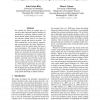77
Voted
NAACL
2004
15 years 2 months ago
2004
Many probabilistic models for natural language are now written in terms of hierarchical tree structure. Tree-based modeling still lacks many of the standard tools taken for grante...
NAACL
2004
15 years 2 months ago
2004
Organizations are increasingly turning to spoken dialog systems for automated call routing to reduce call center costs. To maintain quality service even in cases of failure, these...
83
Voted
NAACL
2004
15 years 2 months ago
2004
In this paper, we will compare and evaluate the effectiveness of different statistical methods in the task of cross-document coreference resolution. We created entity models for d...
89
Voted
NAACL
2004
15 years 2 months ago
2004
Supervised estimation methods are widely seen as being superior to semi and fully unsupervised methods. However, supervised methods crucially rely upon training sets that need to ...
105
click to vote
NAACL
2004
15 years 2 months ago
2004
Maximum entropy models are a common modeling technique, but prone to overfitting. We show that using an exponential distribution as a prior leads to bounded absolute discounting b...
106
click to vote
NAACL
2004
15 years 2 months ago
2004
We describe a methodology for rapid experimentation in statistical machine translation which we use to add a large number of features to a baseline system exploiting features from...
NAACL
2004
15 years 2 months ago
2004
We propose a theory that gives formal semantics to word-level alignments defined over parallel corpora. We use our theory to introduce a linear algorithm that can be used to deriv...
119
Voted
NAACL
2004
15 years 2 months ago
2004
We examine the utility of multiple types of turn-level and contextual linguistic features for automatically predicting student emotions in human-human spoken tutoring dialogues. W...
92
Voted
NAACL
2004
15 years 2 months ago
2004
State-of-the-art pronoun interpretation systems rely predominantly on morphosyntactic contextual features. While the use of deep knowledge and inference to improve these models wo...
NAACL
2004
15 years 2 months ago
2004
Entity detection and tracking is a relatively new addition to the repertoire of natural language tasks. In this paper, we present a statistical language-independent framework for ...

